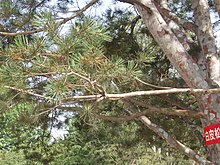Lacebark Pine
| Lacebark Pine | |
|---|---|

| |
| An old tree in China | |
| Scientific classification | |
| Kingdom: | |
| Division: | |
| Class: | |
| Order: | |
| Family: | |
| Genus: | |
| Species: | P. bungeana
|
| Binomial name | |
| Pinus bungeana | |
Lacebark Pine (Pinus bungeana) is a pine tree native to northeastern and central China. It is a slow-growing tree to 15-25 m tall. Its smooth, grey-green bark gradually sheds in round scales to reveal patches of pale yellow, which turn olive-brown, red and purple on exposure to light.

This broad, somewhat bushy tree produces branches that are long and sweep sharply upwards. The needle-like leaves are produced in threes with a deciduous sheath, spread widely apart on the shoots and face forward, glossy green, 6-9 cm long and 2 mm broad. The cones are ovoid, 4-7 cm long and 3-5 cm across, dark brown with relatively few scales. The seeds are 6-8 mm long, with a rudimentary wing, and are dispersed by the Spotted Nutcracker.
Uses
Lacebark Pine is a valuable ornamental tree, grown mainly for its decorative bark. It is said by many to be the most beautiful of all pines. In China, it is widely planted beside temples, with some specimens reported to be over 1,000 years old. It was introduced to Europe and North America in 1846, and specimens are grown in many botanical gardens and occasionally in parks.
References
- Template:IUCN2006 Database entry includes justification for why this species is listed as data deficient

